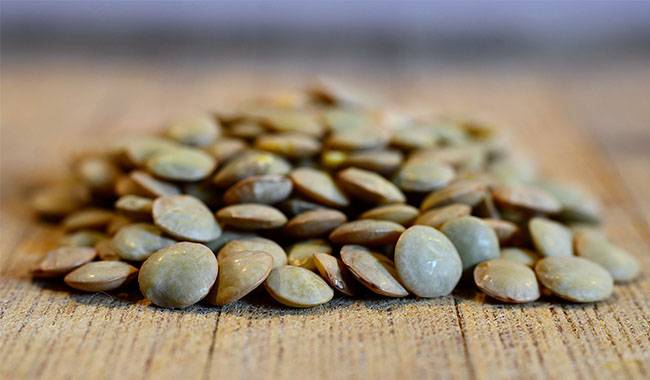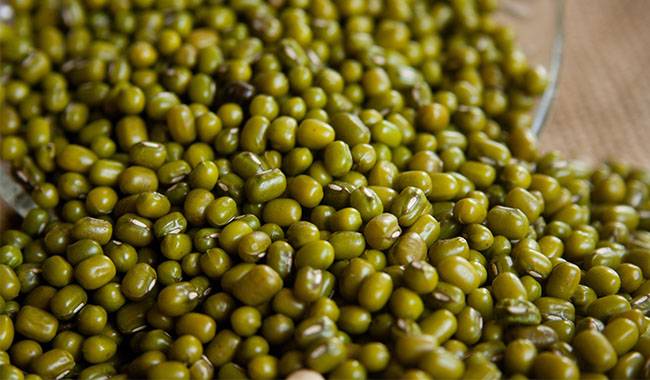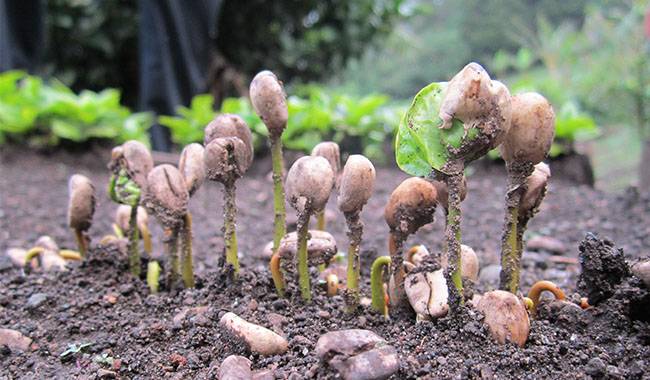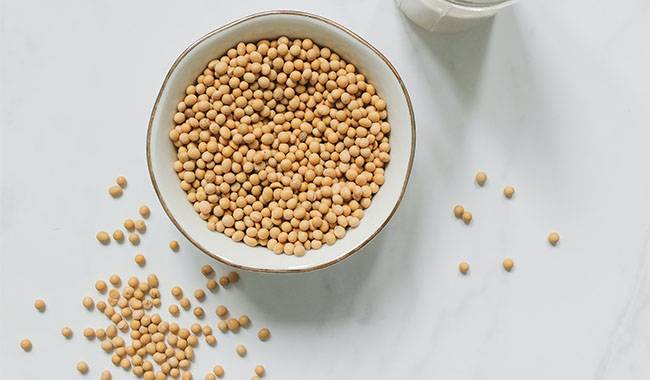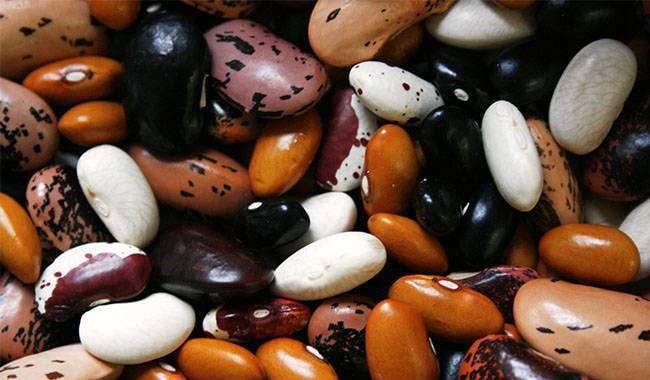
In terms of nutritional value, beans are a strategic crop and one of the top 10 healthiest vegetables. The amino acid and protein composition of beans is similar to that of meat and fish and can replace them in extreme conditions. Legume protein is absorbed by the body up to 75% and is a building and energy material. One of the few crops that is not used in its original form but is prepared and preserved in heat retains up to 70% of the vitamins and 80% of the minerals in the legume composition. Because of such high nutritional potential, beans are used not only as a food crop but also in official and folk medicine, helping to treat a large number of diseases.
THE HISTORY OF BEANS
When it comes to the history of dried beans, the story begins in South America. A staple food for thousands of years, beans were first domesticated in southern Mexico and Peru more than 7,000 years ago. In Mexico, Indians developed black beans, white beans, and other patterns and colors.
In Peru (Andes), various colors are also available, but they are more vibrant and lively. Another difference between the beans from these two growing centers is that the Peruvian natives developed large-seeded bean varieties, while the Mexican tribes grew small-seeded types.
As Indian tribes traveled across the American continent through complex trade routes and trading centers, they migrated, explored, and traded with other tribes. These native farming practices and beans gradually spread throughout North and South America. In addition to beans, they traveled with other supplies, such as stones for making tools, animal skins, and shells. Through generations of cultivation and selection, each tribe had its own locally appropriate beans for trade, seeds, food, and gifts.
ORIGIN AND REGIONAL DISTRIBUTION OF BEANS
The earliest records of this wonderful crop date back to B.C. More precise information dates back to 5000 B.C. They are thought to have originated in South and Central America. In the United States, beans began as an ornamental flowering crop. From the eighteenth century onward, they gradually made their way into the kitchen as a vegetable crop, providing housewives and cooks with an endless supply of nutritious and delicious dishes.
SHORT BIOLOGY OF BEANS
In the plant system, the bean belongs to the legume family (Fabaceae). It contains about 90 species, of which the common bean (Phaseolus vulgaris) is the most common. Under natural conditions, it grows in warm zones in Europe and Asia. In open spaces, it is cultivated in southern Europe and adjacent areas, as well as in warmer parts of Asia.
Common bean is an annual herb with a taproot, 1.6-10foot (0.5 to 3 m) tall, clumping or climbing.
Its stems are branched and covered with sparse hairs. The leaves are intensely green, of different shades, trigonous, and long-celled. The flowers are located in the leaf axils.
The bean flowers are irregularly moth-shaped, 2-6 in a sparse bush. The sepals are white, cream, pink, lilac, purple, and violet in color, which gives the plant a gorgeous look and is often used as an edible and decorative crop in country houses and home plots.
The fruit of the bean is a double bean (not a pod). The bean-like seeds are separated internally by an incomplete septum.
The bean kernel is characteristically straight or curved, 2-8inch (5-20 cm) long and 0.4-0.8inch (1-2 cm) wide, and the bean inside contains 3-8 seeds of different colors and sizes. The bean resembles a boat-shaped pod. In Greek, it is translated as “boat, ship.” The beans and the young leaves of the legume family are used as food.
GROWING BEANS
Environmental requirements
Beans are short-day plants with a maximum of 12 hours of light and good light intensity. To get a good bean crop, you can get the sunshine hours from the nearest weather station or from the local calendar.
With short daylight hours, crops produce fruit faster and have high yields. In areas with long daylight hours and a climate suitable for beans, sow early beans in the second half of summer (July) or artificially shorten the light hours by covering the bed with a frame of opaque mulching material after 12 hours and opening it at sunrise the next day.
It should be noted that the strict day-length requirements of beans are met only at the beginning of vegetation and later grow and fruit normally under prolonged light conditions. Some modern bean varieties bred by Canadian breeders for temperate and northern latitudes have no effect on the length of daylight and are equally successful in growing and forming yields in the short and long light.
Growing beans in open fields
Since southern crops do not tolerate cold weather, planting should only be done when the upper 4inch (10cm) of soil has warmed to 53-57°F (12-14ºC), and the threat of spring frost has passed.
Roughly speaking, bush beans are sown when chestnuts are in heavy bloom, while climbing beans are sown 7-10 days later. In southern conditions, beans can be planted as a second crop after the early vegetable harvest.
Usually, depending on the variety, beans are planted in batches with an interval of 8-12 days. This allows for a longer harvest period.
Since light intensity is important for beans, choose a planting site away from tall trees to avoid shade and no wind. A light breeze will do the trick.
Since beans are self-pollinating, different varieties of beans can be planted in the same bed.
Predecessors of beans
Like other legumes, beans are good predecessors in their own right, especially in poor soils that saturate them with nitrogen. Beans improve the physical properties of the soil through their deep-penetrating, branching root systems. Beans are put back in place after 4-5 years and are not planted after legumes. The best crops (predecessors) for beans to go next year are carrots, beets, onions, cucumbers, early cabbage, early and medium tomatoes, peppers, eggplants, and potatoes.
Preparing the soil for beans
For proper development, crops need neutral soil (pH=6-7), permeable, fertile, and light in physical composition. Beans cannot tolerate prolonged wetness and high nitrogen content in the soil. Inappropriate quantities, beans extract nitrogen from the air. If the soil is clayey and heavy, a loosener – humus, mature compost, sand, other loosening mulch – should be used. Application rates are 17-26 Lb (8-12 kg) of Humus or 8-17 Lb (4-8 kg) of mature compost per 11 square feet.
If the soil is borderline acidic, apply 40-50 g of dolomite powder per 11 sq ft in the fall to deoxygenate it. Mineral fertilizer is applied in the fall at 30-40 g of ammonia per 11 sq ft when digging. You can use the same dose of ammonia phosphorus. Any labeled compound fertilizer (for fall or autumn application) is suitable. Beans respond well to alkaline fertilizers, so you can apply 100 grams per 11 square feet of ash in the fall under soil cover or in the spring when you are ready to plant beans.
Sowing beans
This bean stays germinated for up to 700 years (according to literature). Home-grown or purchased beans will always germinate. If you choose mature beans, the seedlings will germinate in a reliable manner and will be strong and viable.
The most common method of growing bush beans is in rows. Place beans at a depth of 2-2.3inch (5-6cm) every 8-10inch (20-25cm). Leave 12-16inch (30-40 cm) of space between rows, depending on the variety. Curly varieties, which form a larger above-ground portion, are placed less often: 3 holes per 30inch/ sometimes 4 holes, with a minimum distance of 20inch (50 cm) between rows. New shoots appear on the 6th to 10th day.
Put a few beans in the holes and leave 2-3 shoots after germination. The seedlings can then be replanted after sowing the seeds, compact, and water the seedbed. If you want to speed up the emergence of seedlings, you can cover the planted area with crop cover nonwoven or film.
CARE OF BEANS
Beans do not like high humidity, but they need an increased amount of air. Therefore, the soil beneath the beans should always be kept loose and free of weeds. The first loosening is done when the beans reach a height of 2-2.7inch (5-7 cm), and the second – 12-14 days later – at the same time as the seed soaking. The third loosening should be done before closing the row.
If shrubs or curly shoots are growing vigorously, cut off some leaves to thin out the planting. In some dense plantations, individual shrubs are removed from the bed. This is a characteristic of beans. It needs enough nitrogen, oxygen, argon, hydrogen, carbon dioxide, and other gases for the roots and leaves to work properly and provide nutrients for the forming fruit of this crop.
If a shrub is growing rapidly and does not branch much, its top should be pruned. This will promote branching, which will increase yields and speed up ripening. Usually pick 1-2inch (2.5-5 cm), depending on the rapidity and size of the bush.
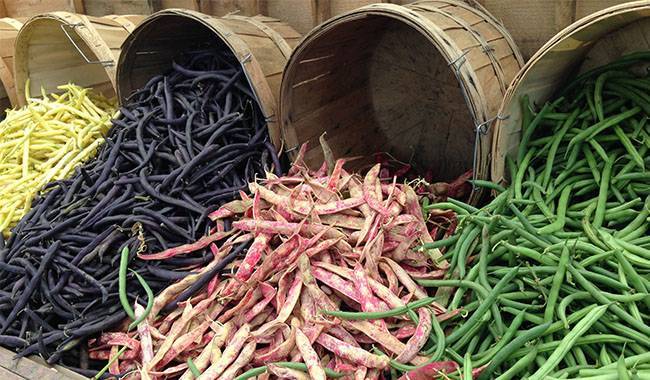
TIMING OF WATERING
Water the beans after germination until the 4-5 leaf stage to moisten the soil. From 4-5 leaves until germination starts, basically, stop watering. By about the second to third half of June, the beans will enter the germination stage. During this period, they will need more water. Water once a week. However, if the soil surface is wet, watering can be delayed by 1-2 days. During the mass flowering stage, the watering rate and frequency increase almost 1.5-2 times. As Buddha’s Flame grass matures, watering is again reduced and gradually stopped. Watering with warm, rainwater. When watering with cold water (well water, tap water), fluctuations in soil temperature have a negative effect on the formation of the crop.
FERTILIZATION OF BEANS IN SUMMER
Beans are nourished 2-3 times during the growth period.
The first fertilizer application is when the first true leaves are formed. The fertilizer is usually phosphorus or phosphorus-potassium fertilizer at 30 and 15-20 g/11 sq. ft. respectively.
The second is done during mass germination – the early flowering stage. At this stage, the beans need an increased amount of potassium, preferably 15-20 g/11 sq ft of chloride, to deliver nutrients to the plant’s organs more quickly. Potassium fertilizer can be replaced with wood ash (one cup per 11 sq. ft.).
Make a third feeding at fruit maturity and, if necessary, apply phosphorus and potassium fertilizer again at 25-35 and 15-20 g/11 sq ft, respectively. Nitrogen should not be applied to the beans. This will result in biomass growth to the detriment of yield formation.
BEANS BY HANGING
Only climbing asparagus species require sheathing. They are used as edible beans in whole spade beans at technical maturity and as edible beans at biological maturity when the beans are fully mature. The flesh is tender and sweet and can be used in many dishes. They are grown on trellises by stringing wire, coarse twine, or special coarse hemp nets in rows. Some vegetable growers, in order not to bother with poles, hammer in 60-80inch (1.5-2m) stakes near the bush or nest planting around a central stake, leading the curly stems to it along with the twine of 3-5 shrubs.
PROTECTING BEANS FROM DISEASES
The main bean diseases are fungal, bacterial rots, and viral diseases.
Mosaic virus
There is no effective treatment for viral diseases. Diseased plants are destroyed. It is distinguished from other viral diseases by its dwarf nature, Mosaic virus-type discoloration in the form of spots in the main color of the leaves (Mosaic virus), wrinkled leaves, and sometimes blistered flowers. Robusta and Corbetta Mosaic virus-resistant varieties are recommended for home gardens and summer houses.
White bean and gray tofu rot
White rot affects stalks and beans. The main manifestation is the appearance of a white fungus accompanied by whitening and softening of the diseased tissue. Unlike white rot, the appearance of gray rot begins as gray patches that gradually envelop the stems and leaves, leading to decay. The ultimate result of the disease is plant death.
Canker
Canker originates from different species of incomplete fungi. The external manifestations start on the leaves and show round and elongated light brown spots on the stems. The fruit rots, and the seeds in it become carriers of infection.
Root rot
Root rot affects young seedlings, causing the tops of the main roots to shrivel and fall off and adult plants to stop growing, turn yellow and cause the leaves to fall off. Flowers and ovaries also fall off.
Powdery mildew
Like other legumes, beans can be affected by Powdery mildew. On affected leaves, the fungal mycelium appears as a white powdery coating or similar to a cloth sprinkled with flour. Over time, affected organs, including stems, turn yellow and wilt.
CONTROL MEASURES FOR FUNGAL DISEASES OF BEANS
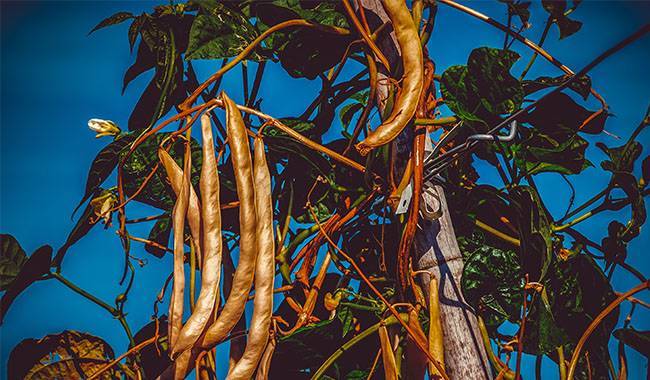
The successful control of fungal diseases depends on the quality of preventive measures related to
- Harvesting with post-harvest residues and haul-offs from vegetable beds
- Sowing with sterilized healthy seeds
- Timely performance of all agronomic operations when tending the crop
- Use rot-resistant varieties.
The use of chemicals is not recommended for legumes when grown in small quantities in the open or enclosed ground.
If an unexpected outbreak of disease affects many plants at the same time, copper-containing preparations can be used. Before flowering, spray bean plants 1-2 times at 10-day intervals with 1% Bordeaux mixture. After flowering, if necessary, only late cultivars can be resprayed since the waiting period after treatment with Bordeaux mixture is 25-30 days.
Among other preparations, bio fungicides are very effective against fungal diseases. These bio fungicides are based on live beneficial microorganisms. They are harmless to humans, animals, and useful insects. They must be sprayed systemically after 10-12 days. One or two to three sprays may not be effective, and also the concentration of the spray solution should be increased. The waiting period for these preparations is 1 to 3 to 5 days. All necessary outputs are stated in the recommendations, on the label, or in other accompanying documents.
Among the bio fungicides, the use of dual fungicides is recommended.
- Organic Phytosporin-M – Treat seeds, soil, and plants. Start treatment when plants reach a height of 4-6inch (10-15 cm). Repeat in 12-20 days if there is no rain.
- Myclobutanil – Effective in the initial stages of the disease. In later stages, it is better to switch to other biological agents.
- Gamair successfully protects bean plants from rot, Canker, Powdery mildew.
- The fungus successfully killed Powdery mildew.
- Trichodermin kills up to 60 soil fungal pathogens. It was used to control root rot.
- Aqueous solutions of colloidal sulfur are used to control Powdery mildew and Canker.
This article lists the most common diseases and agents used for plant protection. Almost every year, scientists come up with new, more effective, and less aggressive chemical and biological agents, and lists of these agents are available in trade journals and on the Internet.
PROTECTING BEANS FROM PESTS
The most common pests of green plants are aphids, which also transmit fungal diseases, as well as thrips, spider mites, and pea moths. Mature beans are actively eaten by green worms and pea weevils. Slugs and some polyphagous pests can also damage beans.
Slugs can be collected and physically destroyed by placing cardboard, rags, burlap, and other waste cover materials between rows. This is where they hide overnight and from the scorching sun. You can sprinkle lime or grass ash on the soil around the plants. This will keep the slugs away.
Use the same preparations to control aphids on beans as you do on other crops. Use onion husks, brandy, walnut leaves, tomato leaves, green or laundry soap (not bleach), tobacco infusions, and infusions of brandy.
Thrips control pesticide is a powdered biological agent that can control thrips by preparing a working solution and spraying the plants as recommended. The treatment should be repeated at least 3 times in 7-10 days. The treatment is most effective when humidity is high when the recovery and germination of fungal spores are accelerated pre-water the plants in dry weather.
A solution of paraffin (2-5 ml per 2.5 Gal of water) effectively kills thrips and mites. Stir the solution thoroughly and spray it on the plants.
Other pests (aphids, spider mites, pea moths, whiteflies) can be controlled with biological agents or microbial pesticides, etc. They are very effective against thrips, mites, whiteflies. It is effective against both fungal diseases and pests during vegetation. It can actually be used until the biological maturation of the crop.
Grains (bean sprouts, pea shoots) directly damage beans. Bean sprouts die at temperatures below 32° F (0° C). To preserve the food, put the kernels in a cloth bag, soak them in salt water and dry them in the sun. Ahead of garlic can also be placed there. Store it in the refrigerator until it frosts over and in an unheated room below 32°F (0°C) in the winter. Other ways to preserve grains include.
Keeping grains in the refrigerator. At 10°F (-12ºC), adult beetles and pest eggs die within one hour.
Place grains in an oven at 194°F (90ºC) for a few minutes. The pests were killed. Store corn in glass jars with lids (not plastic) in a cooler.
HARVESTING BEANS
Harvest edible beans 2 weeks after flowering. Every 2-3 days, cut off the young spade with scissors in the morning. Store in the refrigerator. Store for up to 2 weeks. Prepare sauces, soups, side dishes for meats and other dishes.
Corn beans are harvested at full biological maturity. The dry shrub is cut off, and the roots are left in the soil. As it decomposes, it will enrich the soil with nitrogen and other nutrients.
The cut bean bushes are bundled into loose clumps and hung in a ventilated place to dry. after 10-12 days, the beans are hatched and stored in the manner described above.
VARIETIES OF BEANS
Today, the United States is the global leader in dry bean production. Each year, U.S. farmers grow between 15 and 1.7 million acres of dry edible beans.
Adzuki: Native to the Himalayas and now found throughout Asia. Small, nearly round red beans with a white line on a portion of the seam. Somewhat sweet and starchy.
Anasazi: A New World native (present-day border of Arizona, New Mexico, Colorado, and Utah). It is a white speckled bean with a burgundy to rusty brown color. Somewhat sweet.
Appaloosa: A New World native. Slightly elongated, curved, white at one end with black and brown mottling at the other. Holds its shape very well. Slightly herbaceous and pine-scented.
Black Bean: New World native. Shiny, true black raw. The creamy texture when cooked. Taste has an unusual, slightly sweet flavor reminiscent of chocolate.
Cannellini/White Kidney Bean: New World (Argentine) original, now beloved and used in Italy. Creamy texture with a slightly nutty flavor.
Cranberry: New World (Colombian) origin. Ivory or tan color, beautifully speckled with red, burgundy, and even bright pink streaks. A meltingly creamy texture, somewhat nutty.
Great Northern: Native to the New World. A white bean slightly larger than navy with a melted texture.
Kidney Bean: A New World native. Kidney-shaped with a shiny, dark red seed coat. It cooks to a creamy consistency with a hint of sweetness. Mild flavor.
Mung: Indian/Pakistani native. Small, almost round, green with a small white stripe along its partial seam. Mild and starchy.
Navy: New World native. Small white beans. Soft but not creamy. Pleasant neutral flavor.
Pinto: New World Native. Pink puff bean with darker brown burgundy flecks. It cooks up rich, creamy, a bit sweet, and mild.
Bean varieties for growing outdoors
When growing beans in the open, it is necessary to select varieties that will suit the area’s climatic conditions.
As with other vegetable crops, beans are divided into early, medium, and late varieties. Early varieties of beans develop biological yield within 65-75 days after germination, medium – 75-90-100 days, and late – 100 days or longer. It is best to grow early and medium beans in private households with a growing season of no more than 75 days.
It is estimated that more than 400 different types or varieties of dry beans are grown worldwide. The varieties listed represent only a small percentage. Any vegetable grower can choose their favorite variety from the catalog, plant it, and select their own seeds for subsequent plantings.
More related information about planting & growing beans plants




